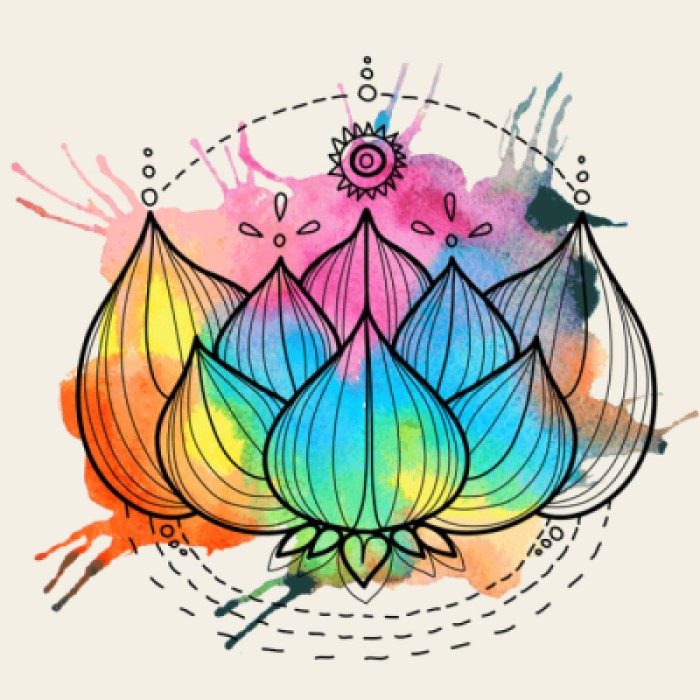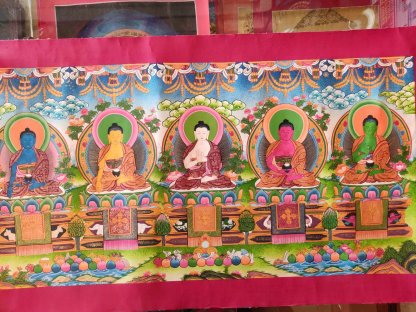We need your consent to the use of individual data so that you can show information about your interests, among other things. Click "OK" to give your consent.
5 Dyani Buddha family Thangka Tathagatas with gold
The Five Wisdom Buddhas are a development of the Buddhist Tantras, and later became associated with the trikaya or "three body" theory of Buddhahood. While in the Tattvasaṃgraha Tantra there are only four Buddha families, the full Diamond Realm mandala with five Buddhas first appears in the Vajrasekhara Sutra.[1]
Representations of the five Dhyani Buddhas, who are abstract aspects of Buddhahood rather than Buddhas or gods, have elaborate differences.[6] Each must face in a different direction (north, south, east, west, or center), and, when painted, each is a different color (blue, yellow, red, green, or white). Each has a different mudrā and symbol; embodies a different aspect, type of evil, and cosmic element; has a different consort and spiritual son, as well as different animal vehicles (elephant, lion, peacock, harpys or garuda, or dragon).[7]
The Vajrasekhara also mentions a sixth Buddha, Vajradhara, "a Buddha (or principle) seen as the source, in some sense, of the five Buddhas."[1]
The Five Buddhas are aspects of the dharmakaya "dharma-body", which embodies the principle of enlightenment in Buddhism.
Initially, two Buddhas appeared to represent wisdom and compassion: Akshobhya and Amitābha. A further distinction embodied the aspects of power, or activity, and the aspect of beauty, or spiritual riches. In the Golden Light Sutra, an early Mahayana text, the figures are named Dundubishvara and Ratnaketu, but over time their names changed to become Amoghasiddhi, and Ratnasambhava. The central figure came to be called Vairocana.
Vairocana, the first Dhyani Buddha, embodies sovereignty. [7] Japanese Pure Land Buddhists think that Vairocana and the other Dhyani Buddhas are manifestations of Amitābha, but Japanese Shingon Buddhists think that Amitābha and the other Dhyani Buddhas are manifestations of Vairocana.[8]
Akshobhya, the second Dhyani Buddha who embodies steadfastness and faces east. He is seated in the Vajraparyanka (also known as Bhūmisparśa) pose, with the right hand on the right knee, palm turned inwardly, and middle finger touching the ground.[7][9][10]
Amitābha (Japanese: Amida) is the most ancient Dhyani Buddha, embodying light and facing west, and is the central figure in Pure Land Buddhism. A statue of Amitābha, when seated, has a samadhi mudrā with both palms face up, on top of each other, in his lap.[7][11][12]
When these Buddhas are represented in mandalas, they may not always have the same colour or be related to the same directions. In particular, Akshobhya and Vairocana may be switched. When represented in a Vairocana mandala, the Buddhas are arranged like this:
White -Vairocana-element space
Red -Amitabha-element fire
Green-Amogasiddhi-element air
Yellow-Ratnasambhava-Element earth
Blue-Absoghya-Element water
Source from https://en.wikipedia.org/wiki/Five_Tath%C4%81gatas
Velikost/Size/Groesse/taille 76/37cm
| Product code | 222600264585 |
|---|---|
| Warranty | 2 years |




 Cookie - Settings
Cookie - Settings
